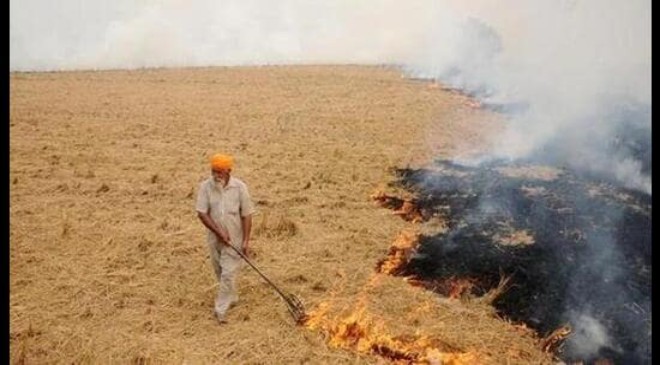Visuals of stubble burning from Punjab on Thursday indicate these good days may be over soon in the coming weeks. Over the last several years, stubble burning in the city’s neighbouring states chokes Delhi during winters
Read More: Haryana Announces 20 pc Reservations For SCs in Group A and B Promotions
‘Tis The Season’ Delhiites fall in love with every year, after ‘Cruel Summer’ (not Taylor Swift’s one), when clear blue skies are visible during the day and a slight nip in the air in the evenings makes them head out as they try to seize these days before ‘Dilli Ki Sardi’ (winter of Delhi) when the city becomes “gas chamber”.
Visuals of stubble burning from Punjab on Thursday indicate these “good air” days may be over soon in the coming weeks. Over the past several years, stubble burning in the city’s neighbouring states chokes Delhi during winters.
The overall Air Quality Index (AQI) of Delhi on Thursday evening was at 121 (Moderate category), as per SAFAR-India (System of Air Quality and Weather Forecasting And Research).
The air quality of Delhi during the January-August period in 2023 was quite good as compared to the corresponding period in the last five years barring the COVID-affected 2020.
Read More: Aditya-L1 Mission to be Launched At 11:50 AM on September 2 From Sriharikota: ISRO
The Commission for Air Quality Management (CAQM), a statutory body tasked with air quality management in the Delhi-NCR region, released a report in August which said that Delhi witnessed the highest number of days (163) with “good” to “moderate” air quality (daily average AQI less than 200) during the January-August period in 2023 as compared to the corresponding period in the last five years.
Fighting Air Pollution: CM to Launch Action Plan
Delhi Chief Minister Arvind Kejriwal is set to launch an action plan aimed at addressing air pollution during the winter season in the city, as confirmed by Environment Minister Gopal Rai on Tuesday. Last year’s action plan primarily concentrated on managing stubble burning, mitigating dust pollution, regulating vehicular emissions, preventing open burning of garbage, and tackling industrial pollution, among other measures.
Rai stated that they are currently formulating a winter pollution action plan for Delhi, based on recommendations provided by relevant departments. He emphasized that construction agencies have been instructed to rigorously adhere to the regulations related to controlling dust pollution. The statement quoted Rai as saying, “Instructions have been issued to all construction agencies to strictly follow the norms related to dust pollution.”
Furthermore, Rai announced that Chief Minister Kejriwal will officially unveil the winter action plan on September 29. He highlighted that distinct winter action plans will be developed for each of the pollution hotspots in the city, addressing the specific sources of pollution in these areas.
Read More: Day Of Successful Landing Of Chandrayaan-3: August 23 Declared National Space Day
The identified pollution hotspots in Delhi include Anand Vihar, Wazirabad, Vivek Vihar, Wazirpur, Ashok Vihar, Dwarka, Jahangirpuri, Rohini, Bawana, Narela, Mundka, Punjabi Bagh, RK Puram, and Okhla Phase 2. These areas will receive tailored measures to address their unique pollution challenges.
LG Raises Issue at North Zonal Council Meet
Delhi LG VK Saxena on Tuesday raised the issue of air pollution in the national capital caused by stubble burning in neighbouring states at the north zonal council meeting and urged them to work in tandem to address the issue.
Saxena said that while Rajasthan, Haryana and Uttar Pradesh, which is not a part of NZC, had undertaken substantial efforts to address the menace, Delhi suffered “acute air pollution” due to the smoke emanating from Punjab despite his letter to the state chief minister on November 4, 2022, they said.
The LG said in the meeting that Delhi had taken several measures to address local causes of air pollution, including end-to-end carpeting and greening of pavements to prevent dust pollution, banning construction activities and using water sprinklers, anti-smog guns during the peak of the problem in winters.
Haryana to Eliminate Farm Fires: CAQM
Haryana has set an ambitious goal of virtually eradicating farm fires this year, as announced by the CAQM (Commission for Air Quality Management). According to the Haryana government’s estimates, approximately 14.82 lakh hectares of land in the state are dedicated to paddy cultivation, expected to yield over 7.3 million tonnes of paddy straw (non-basmati).
To achieve this, Haryana has harnessed satellite data to pinpoint areas where stubble burning is most prevalent. The state plans to manage around 5 lakh acres of paddy fields using the Pusa Bio Decomposer. This microbial solution can break down paddy straw in just 15-20 days and will be provided to farmers for free, it added.
In addition to providing alternatives to stubble burning, the Haryana government has introduced financial incentives to discourage this practice. The government has set a purchase price of Rs 2,500 per tonne for paddy crop residue from farmers. Furthermore, farmers will receive Rs 1,000 per acre for managing paddy crop residue either on-site (in-situ) or off-site (ex-situ), as stated by the CAQM.
To further motivate farmers and panchayats to refrain from burning crop residue, the CAQM has outlined additional incentives. Panchayats that completely halt crop residue burning will be eligible for incentives ranging from Rs 50,000 to Rs 1 lakh. Additionally, farmers needing to transport leftover crop residue to facilities like gaushalas will receive Rs 500 per acre, with a maximum limit of Rs 15,000, according to the CAQM.
Punjab to Reduce 50% Farm Fires: CAQM
Punjab has also submitted an action plan and has pledged to achieve a significant reduction of over 50% in farm fires when compared to the levels observed in 2022, the Commission for Air Quality Management said.
The CAQM has announced that the action plan includes the ambitious goal of completely eliminating farm fires in six districts of Punjab. This plan was developed following a series of four meetings held with the state government over the past few months, involving the state’s chief secretary and deputy commissioners from all districts.
Read More: Eight Dead, 20 Injured After Fire Breaks Out in Bharat Gaurav Tourist Train Near Rameswaram
The plan attempts elimination of paddy stubble burning cases this year in six districts, namely Hoshiarpur, Malerkotla, Pathankot, Rupnagar, SAS Nagar (Mohali) and SBS Nagar, the CAQM has said as reported by Hindustan Times.





































